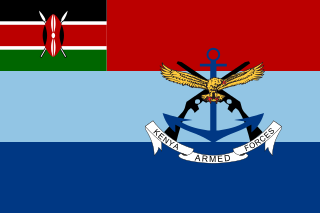
The Kenya Defence Forces (KDF) are the armed forces of the Republic of Kenya. They are made up of the Kenya Army, Kenya Navy, and Kenya Air Force. The current KDF was established, and its composition stipulated, in Article 241 of the 2010 Constitution of Kenya; it is governed by the KDF Act of 2012. Its main mission is the defence and protection of the sovereignty and territorial integrity of Kenya, recruitment to the KDF is done on yearly basis. The President of Kenya is the commander-in-chief of the KDF, and the Chief of Defence Forces is the highest-ranking military officer, and the principal military adviser to the President of Kenya.

Isiolo is a town in Isiolo County, of which it is the capital. It is located in the upper eastern region of Kenya and is geographically considered the center of the country Kenya. It lies 285 kilometers north of the capital Nairobi. The town grew around the local military camps, much of the population being Ameru community, Borana, and the descendants of former Somali soldiers who had fought in World War I. The town has an estimated population of 78,250, most of them living around the outskirts of the town. Like most African cities, there has been a steady increase in the urban population in recent years, especially moving from as far as Moyale, Marsabit and Mandera. Isiolo town is also becoming a centre of interest because of its newly acquired status as a resort city cashing in on the popular Samburu and Shaba Game reserves, which have become preferred destinations after the famed Maasai Mara. Isiolo lies along the long A2 Road, leading towards Marsabit and Moyale much further north.
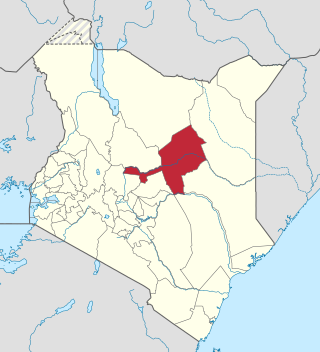
Isiolo County is a county in the former Eastern Province of Kenya. Its population is 268,002 and its capital and largest city is Isiolo. Isiolo County is to be the first county to be developed as part of the Kenya Vision 2030 program. Other upcoming urban centres are: Garbatulla, Modogashe, Kinna, Merti and Oldonyiro.The county is home to Sakuye and Borana tribes but also has a significant number of people from Turkana, Samburu, Gabra, Garre and Meru communities.

Garissa County is an administrative county in Kenya. It is located in Eastern Kenya bordering Somalia to the East, Wajir County and Isiolo County to the North, Tana River County to the West and Lamu County to the South. Its capital and largest urban area is Garissa.

Wajir County is a county in the former North Eastern Province of Kenya. Its capital and largest town is Wajir. The county has a population of 781,263 and an area of 55,840.6 km2 (21,560.2 sq mi). The county is bordered to the north by Ethiopia, to the northeast by Mandera County, to the east by Somalia, to the south by Garissa County, to the west by Isiolo County and to the northwest by Marsabit County. The county has six constituencies: Wajir South, Tarbaj, Wajir North, Wajir West, Wajir East, and Eldas.
The Shifta War or Gaf Daba (1963–1967) was a secessionist conflict in which ethnic Somalis in the Northern Frontier District (NFD) of Kenya attempted to join Somalia. The Kenyan government named the conflict "shifta", after the Swahili word for "bandit", as part of a propaganda effort. The Kenyan counter-insurgency General Service Units forced civilians into "protected villages" as well as killing livestock kept by the pastoralist Somalis.

The Sakuye are people living in Marsabit, Tana River, Mandera and Isiolo counties, as well as the Northern Frontier District.
The Wagalla massacre was a massacre of ethnic Somalis by the Kenyan Army on 10 February 1984 in Wajir County, Kenya. Government troops were ordered to stop clan violence in the area, and did so by first detaining some 5,000 locals at an airstrip, denying them food and water for a week, and then shooting them. The massacre was not investigated by Kenya's government until 2011.

Mohamed Yusuf Haji was a Kenyan politician. He was the Minister of Defence of Kenya from 2008 to 2013, and briefly served as its acting Minister of Internal Security and Provincial Affairs in 2012. He has served in the Senate of Kenya since 2013 under the jubilee party. He died on 15 February 2021.
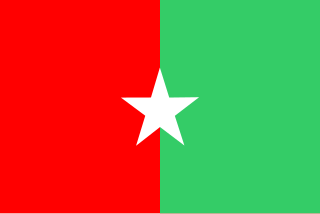
Somalis in Kenya are citizens and residents of Kenya who are of Somali ethnic descent. They have historically inhabited the North Eastern Province, previously called the Northern Frontier District, which was carved out of the Jubaland region of present-day southern Somalia during the colonial period. Following the civil war in Somalia that broke out in 1991, many Somalis sought asylum in the Somali-inhabited enclaves of Kenya. An entrepreneurial community, they established themselves in the business sector, particularly in the Nairobi suburb of Eastleigh.
Isiolo Airport, also Isiolo International Airport is an airport located in Isiolo, Isiolo County, and Meru County, Kenya.

The units of the Kenya Army Infantry are the principal fighting arms of the Kenya Army. The primary mission of the Infantry formations is to fight and win land battles within area of operational responsibilities in the defence of the nation against land – based aggression, while the secondary mission is the provision of aid and support to civil authorities in the maintenance of order. The Kenyan School of Infantry (SOI) is located in Isiolo County.
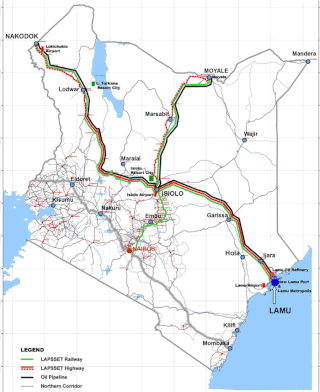
Lamu Port-South Sudan-Ethiopia-Transport (LAPSSET) Corridor project, also known as Lamu corridor is a transport and infrastructure project in Kenya that, when complete, will be the country's second transport corridor. Kenya's other transport corridor is the Northern Corridor, which links Mombasa to Uganda, passing through Nairobi and much of the Northern Rift. Some basic LAPSSET infrastructure has been built. The construction of LAPSSET's main components is currently ongoing with construction of the first berth at Lamu Port completed in October 2019.. Although the project is not formally stalled, its short to medium term success looks increasingly unlikely. Insecurity and political instability in Kenya are mostly to blame for this, as are more commercially viable alternative pipeline options through Tanzania or Ethiopia. The low oil prices since 2015 also affect LAPSSET's commercial prospects.
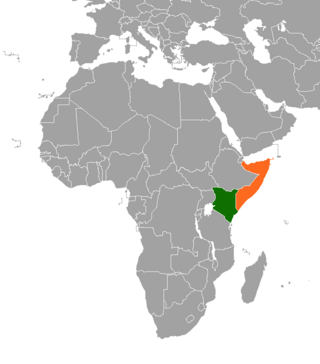
The Somali–Kenyan conflict has been an issue within Kenya since the colonial period. Problems have ranged from skirmishes between the two communities and have led to terrorist attacks, police harassment, extortion, home invasions, physical violence, and massacres perpetrated against Somalis and Kenyans.

Sub-counties, also known as Districts, are the decentralised units through which government of Kenya provides functions and services. At national level, sub-counties take a more administrative function like security, statistical purposes, provision of government services, etc. Even though the sub-counties are divisions of counties, powers to create new national sub-counties lies with the national government. As of 2023, there are 314 sub-counties, compared to 290 constituencies. A deputy county commissioner is appointed by the state to lead each sub-county. The sub-counties are further divided into divisions, locations and sub-locations.

Ethiopia–Kenya relations are bilateral relations between Ethiopia and Kenya. The two nations maintain primarily trade ties.
On 2 April 2015, gunmen stormed the Garissa University College in Garissa, Kenya, killing 148 people, and injuring at least 79. The militant groups Al-Qaeda and Al-Shabaab, which the gunmen claimed to belong to, took responsibility for the attack. The gunmen took over 700 students hostage, freeing Muslims and killing those who identified as Christians. The siege ended the same day, when all four of the attackers were killed. Five men were later arrested in connection with the attack, and a bounty was placed for the arrest of a suspected organizer.

The Battle of El Adde took place on 15 January 2016. Al-Shabaab militants launched an attack on a Kenyan-run AMISOM army base in the town of El Adde, Gedo, Somalia. It remains the deadliest attack on the African Union Mission to Somalia and is the Kenya Defence Forces (KDF) largest defeat since independence in 1963. As such, the Kenyan government went to extreme lengths to conceal the extent of its losses. It has been described by the media as a "military massacre" or military disaster. It was also the largest military defeat in Kenyan history.
Fatuma Adan Dullo is a Kenyan politician and the current elected Senator for Isiolo County as well as the shortest serving Minority Whip. She once served as the Deputy Majority Leader – Senate of the Republic of Kenya. Fatuma Dullo made history after being among the first three female senators to be elected as well as the only one from the Northeastern Region. She is a lawyer and an Advocate of the High Court of Kenya and previously served in various capacities in the public sector and in civil society. Her expertise is in public administration, governance and human rights advocacy. Her interests include human rights and education particularly of marginalised groups, community mobilisation and capacity-building.
Grace Lolim is a Kenyan human rights and peace activist, the chair of the Isiolo Peace Committee, and the founder and executive director of Isiolo Gender Watch.















